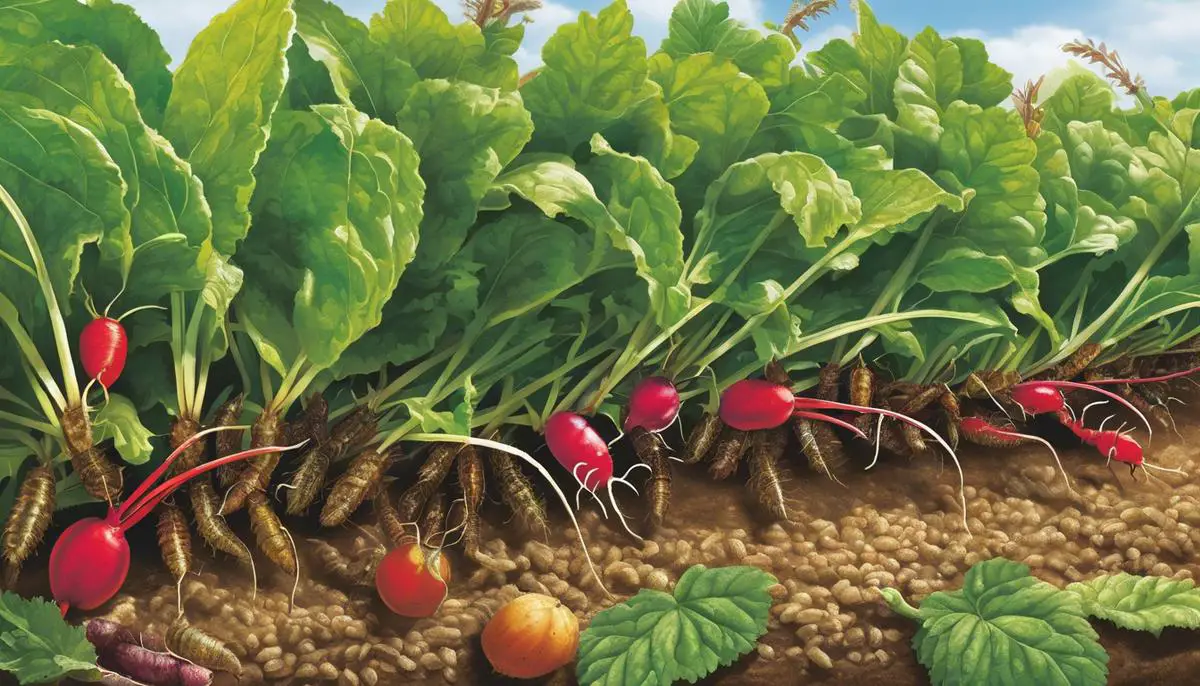The humble radish, a root vegetable of great culinary value, enjoys popularity around the globe for its crunchy texture and peppery flavor. However, like many agricultural treasures, it is vulnerable to a host of voracious pests and debilitating diseases that threaten its growth and yield. A thorough understanding of the biological warfare at play beneath the surface and between the leaves is critical for protecting these piquant bulbs. This essay endeavors to unpack the hidden world of radish adversaries, from the tiny flea beetle to the destructive root maggot, alongside the diseases that stealthily undermine plant vitality such as clubroot and downy mildew. Our journey delves into the intricacies of identification, pathology, and the ever-important integrated pest management strategies, shedding light on the innovative, sustainable techniques that safeguard radish crops and support the health of our ecosystem.
Identification of Radish Pests
Plagues of the Radish: Identification and Characteristics of Major Pests
Abstract:
Reader Poll: What online courses would interest you?
Within the agricultural sphere, radiculture has emerged as both a commercially and nutritionally significant venture, replete with myriad challenges pertinent to pest management. The discourse herein endeavors to elucidate upon the primary pests that afflict radish crops (Raphanus sativus), emphasizing both their identification and their biological predilections. Through this exposition, the criticality of astute monitoring and timely intervention shall be underscored to safeguard radish yield and quality.
Introduction:
The cultivation of radishes, a cruciferous vegetable, is not insulated from the biotic stresses that pervade agricultural systems. Among these, insect pests present a formidable threat, often necessitating targeted control strategies. Recognizing the phenotypic and behavioral characteristics of these pests is paramount in enabling effective mitigation and maintaining crop integrity.
Subscribe to our newsletter!
Flea Beetles (Phyllotreta spp.):
Their propensity for radish crops is marked by distinct feeding patterns. Evinced by the appearance of numerous small, round holes riddling the foliage, flea beetles are diminutive yet insidious culprits. They can be visually identified by their glossy, oval-shaped bodies, often adorned with metallic hues, and their remarkable jumping ability when disturbed.
Root Maggots (Delia radicum):
Root maggots, or cabbage maggots as they are commonly known when infesting allied vegetables, are larval stages of a fly. In radishes, their presence is betrayed by the wilting and yellowing of leaves, preceded by the deposition of eggs at the base of the stem. The maggots themselves are inconspicuous, white larvae found burrowed within the root tissues, orchestrating decay.
Aphids (Aphis spp.):
Typified by their soft, pear-shaped bodies and diminutive stature, aphids colonize on the undersides of leaves and tender shoots. Infestations are discernible via the secretion of honeydew, which facilitates the growth of sooty mold and the ensuing discoloration of plant surfaces. Additionally, these pests may induce the curling and distortion of foliage.
Cutworms (Noctuidae family):
Cutworms inflict damage to radishes during their larval phase, often severing young plants at the soil line. These nocturnal feeders coil around stems and consume plant matter, and thus, damage is typically observed as clean cuts near the ground. The larvae exhibit a variety of colors, ranging from gray to brown, and feature smooth, plump bodies.
Conclusion:
The overarching imperative for radish cultivators is to maintain vigilance against these primary pests. By harnessing the diagnostic characteristics laid out herein, swift identification can be actualized. As these pests are both diverse and adaptive, their management necessitates an integrated approach, combining cultural, biological, and, when judiciously applied, chemical controls. Elevated understanding of these pestilent actors fortifies the bulwarks of radiculture, ensuring the continued provision of this nutritious, edible root.
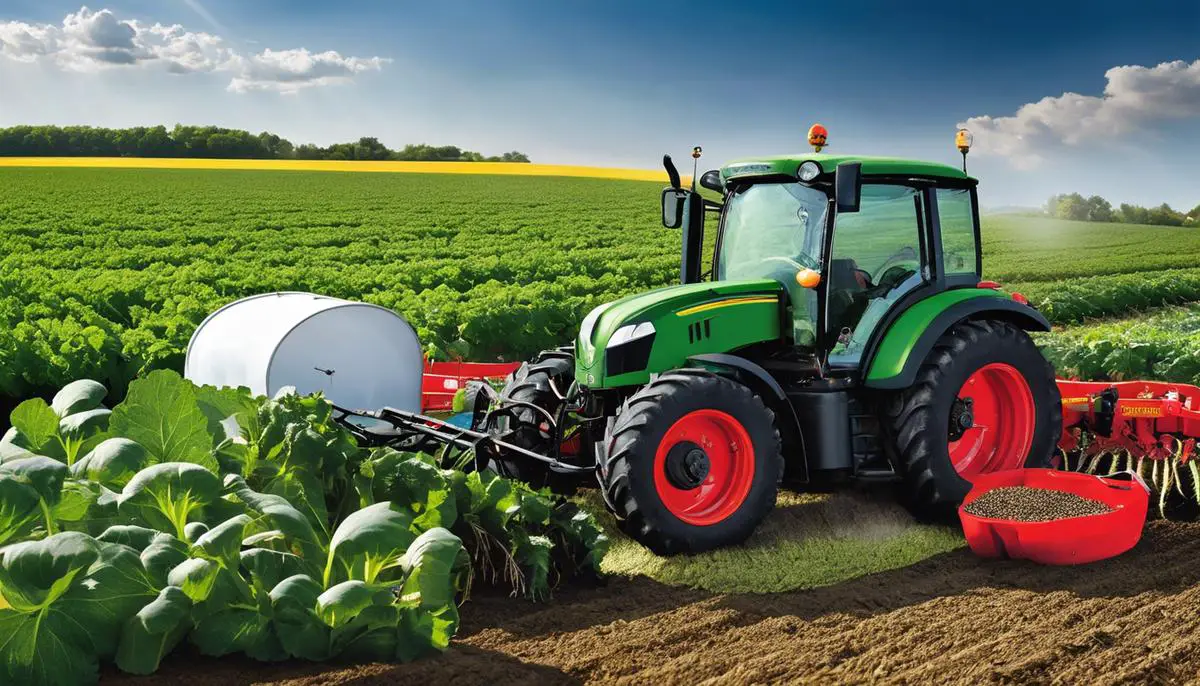
Pathologies Affecting Radishes
Continuing the examination of the maladies afflicting the radish (Raphanus sativus), one must delve into the realm of plant pathologies that significantly affect the health and yield of this cruciferous vegetable.
The scientific scrutiny of such diseases is imperative for the development of effective countermeasures to ensure agricultural stability and productivity.
One of the most pernicious diseases affecting radish crops is clubroot, caused by the soilborne pathogen Plasmodiophora brassicae.
The disease manifests through the growth of galls on the roots, thereby restricting water and nutrient uptake.
These deformations are a direct result of the pathogen’s lifecycle, which involves the release of resting spores into the soil that later infect the root hairs of the host.
The resultant hypertrophy and hyperplasia—a pronounced swelling and increased cell proliferation—challenge the plant’s vascular system, often leading to wilting and stunted growth.
Another critic of radish health is white rust, caused by the oomycete Albugo candida.
This disease is noticeable by the white, blister-like pustules that appear on the underside of leaves.
These eruptions release sporangia that can initiate new infections.
The disruption of photosynthetic capabilities and the defacement of marketable foliage substantially depreciate the commercial value of affected crops.
Furthermore, radishes are susceptible to the fungal pathogen Rhizoctonia solani, known for causing damping-off, wirestem, and root rot.
These conditions, although diverse in their manifestation, are linked by the pathogen’s modus operandi, which involves the colonization of the cortical cells of the root system.
The integrity of the root structure is compromised, ultimately leading to the collapse of the plant.
It is worth noting that cool and moist soil conditions are particularly conducive to the proliferation of Rhizoctonia solani.
Powdery mildew, while commonly afflicting a multitude of plant species, does not spare the radish.
Caused by fungi such as Erysiphe cruciferarum, it coats the leaves with a whitish, powdery film.
The primary mode of operation is the parasitization of epidermal cells, which impedes the radish’s ability to photosynthesize efficiently, thus sapping the energy reserves vital for growth and maturation.
Lasttly, it is important to draw attention to the relatively cryptic but harshly destructive nematodes, particularly the root-knot nematodes (Meloidogyne spp.).
These microscopic parasites invade the root system and establish feeding sites, eliciting the formation of gall-like structures.
These galls are indicative of severe disruptions to the radish’s ability to transport water and nutrients from the soil, which can culminate in the retardation of the entire plant’s growth and developmental processes.
While this enumeration of diseases is not exhaustive, the described pathogens hold a particularly notorious reputation within radiculturist circles.
Their mechanisms of harm, whether through structural deformation, parasitism, or interruption of physiological processes, highlight the myriad of challenges that plant pathologists and growers alike face in the cultivation of healthy radish crops.
Therefore, ongoing research and the dissemination of knowledge in the control of these diseases remain quintessential for both academic and applied aspects of plant science.
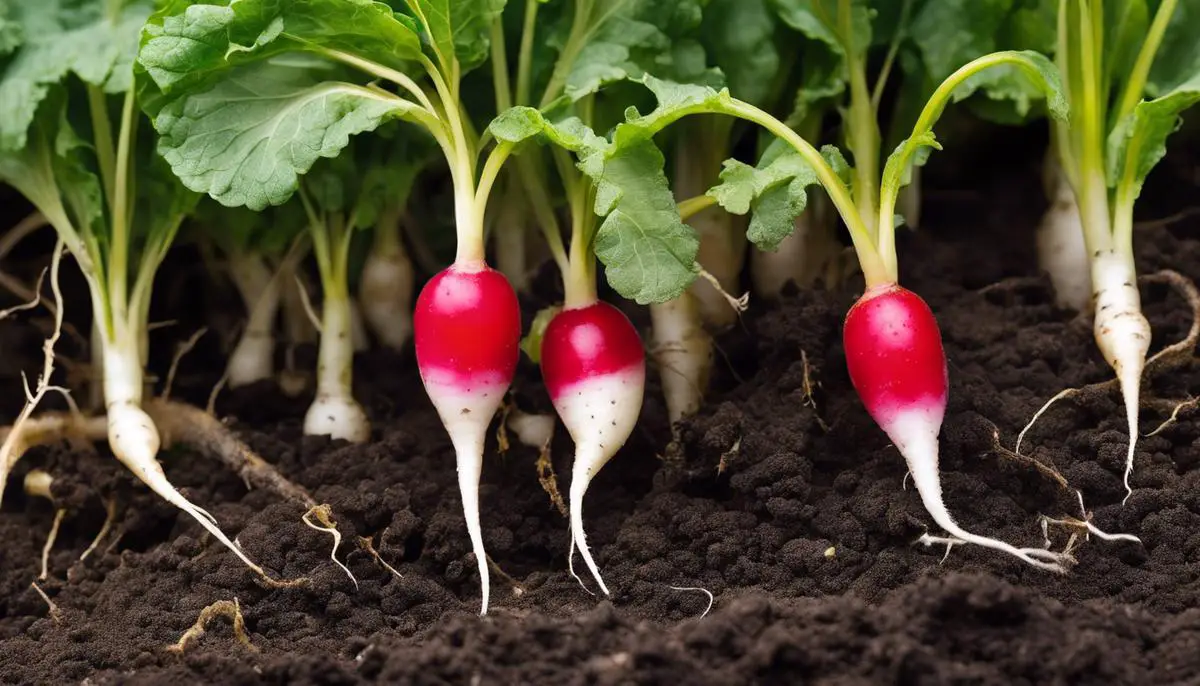
Integrated Pest Management (IPM) Strategies
Understanding the complexity of biotic stressors in radish cultivation necessitates a strategic approach to manage both pests and diseases. In the sphere of Integrated Pest Management (IPM), the focus extends to diseases that afflict radish crops, which can be as detrimental as pests, if not more so. Recognizing this reality, adaptation of IPM principles to address disease challenges is indeed paramount.
Clubroot, a disease inflicted by Plasmodiophora brassicae, is a formidable pathogen affecting radishes and other crucifers. It triggers gall formation on roots, which results in significant yield losses and compromised product quality. IPM strategies against clubroot involve crop rotation with non-host species and the utilization of resistant cultivars. Furthermore, the maintenance of soil pH above 7.2 with liming can suppress the pathogen’s proliferation. Sanitization of agricultural tools is also critical to prevent pathogen spread between fields.
White rust, caused by Albugo candida, manifests as white pustules on the leaves and stems and can drastically reduce the photosynthetic capacity of radish plants. Adaptation of IPM to this disease includes the implementation of fungicide rotations that target the lifecycle of the pathogen alongside the enforcement of crop rotations that can hinder the pathogen’s ability to overwinter on volunteer plants or plant debris.
Radishes are not immune to the threats posed by Rhizoctonia solani, which can lead to damping-off in seedlings, wirestem in maturing plants, and root rot in storage. The integrated management of this disease requires the use of fungicidal seed treatments, sanitation of planting equipment, and the careful selection of well-drained planting sites. Soil solarization, the practice of using solar radiation to heat the soil, can further reduce the persistent inoculum in the field.
Powdery mildew, primarily caused by fungi such as Erysiphe cruciferarum, can cover radish leaves with a white, powdery coating, impeding their growth. Cultural IPM practices involve enhancing air circulation among plants and reducing humidity levels. Biological control agents, such as Bacillus subtilis, hold promise as part of an IPM strategy to prevent or reduce outbreaks.
Lastly, addressing root-knot nematodes, particularly Meloidogyne spp., requires strategic tactics, as these microscopic parasites form knot-like galls on roots that drain the plant’s resources. Crop rotation with non-host species, soil solarization, and the use of nematicidal plants or compounds can be integrated into an effective management plan.
In the quest to defend radish crops against a diversity of pests and diseases, the implementation of such IPM adaptations not only aims to minimize impact but also to advance sustainable agricultural practices that safeguard both crops and ecosystems. The intricacies of these measures and their application underscore the scientific and passionate pursuit of agricultural excellence through conscientious and informed crop management.

Biological and Organic Control Methods
The pursuit of alternative pest and disease management in radiculture continues to gain momentum, as environmentally conscious methods supplant synthetic chemical applications. Biological and organic control measures present a commendable strategy for mitigating the detriments posed by radish pests and diseases, fostering sustainable agricultural ecosystems. Herein, we delineate several of these prudent biological and organic interventions for radish cultivation.
Biological Pest Control Methods
Bacillus thuringiensis var. kurstaki, a pathogenic bacterium, has been identified as an effective biological control for lepidopteran pests such as cutworms. This bacterium produces proteins with insecticidal properties, and when ingested by larvae, leads to their demise usually within two to three days. The specificity of Bacillus thuringiensis ensures minimal collateral impact on non-target organisms, an attribute of utmost significance in ecological conservation.
Predatory Insects such as lady beetles (Coccinellidae) and lacewings (Chrysopidae) can be introduced to the radish environment to curb aphid populations. These predatory species voraciously feed on aphids, providing a natural check to their proliferation. Parasitic wasps of the family Braconidae similarly hold potential in the management of root maggot populations by parasitizing the larvae.
Entomopathogenic Nematodes of the genera Steinernema and Heterorhabditis offer a biological solution against soil-dwelling stages of various pests. Given their ability to locate and destroy their hosts from within, these nematodes can be applied through soil drenches to address the menaces of root maggots and cutworms.
Organic Disease Control Methods
Trichoderma spp. are beneficial fungi with a reputation for antagonizing various pathogenic fungi, including those causing damping-off, wirestem, and root rot. The application of Trichoderma preparations can promote radish health through the suppression of detrimental fungal pathogens.
Cultural Practices also play an indispensable role in disease control. Soil solarization, heating the soil by covering it with a transparent polythene film, is an organic method that can diminish the inoculum levels of various pathogens, including Rhizoctonia solani. It does so by elevating soil temperatures to lethal levels for a range of soil-borne pathogens and pests.
Botanical Fungicides derived from natural substances provide an organic arsenal against fungal diseases. For instance, neem oil has shown promise in managing white rust and powdery mildew thanks to its fungicidal properties. While less potent than synthetic fungicides, botanical preparations hold allure for their environmental friendliness and role within an integrated pest management program.
Resistant Cultivars represent another forward front in the quest for organic pest and disease control. Continuous research and breeding efforts have yielded radish varieties exhibiting resistance to common afflictions like root-knot nematodes, and these should be leveraged where viable to reduce reliance on chemical interventions.
Implementing Interplanting and Biodiversity amidst radish crops can improve the overall resilience of the agricultural environment. By cultivating radishes alongside other species, potential pests and diseases may be confused or repelled, thus diminishing the likelihood of infestations and subsequent crop damage.
In conclusion, the adoption of biological and organic control methods for radish pests and diseases not only aligns with the principles of sustainable agriculture but also demonstrates a commitment to patronizing practices that preserve both plant health and the surrounding ecosystem. Such an approach, meticulously backed by scientific inquiry and the zealous pursuit of agronomic excellence, undergirds the future of resilient and environmentally attuned radiculture.
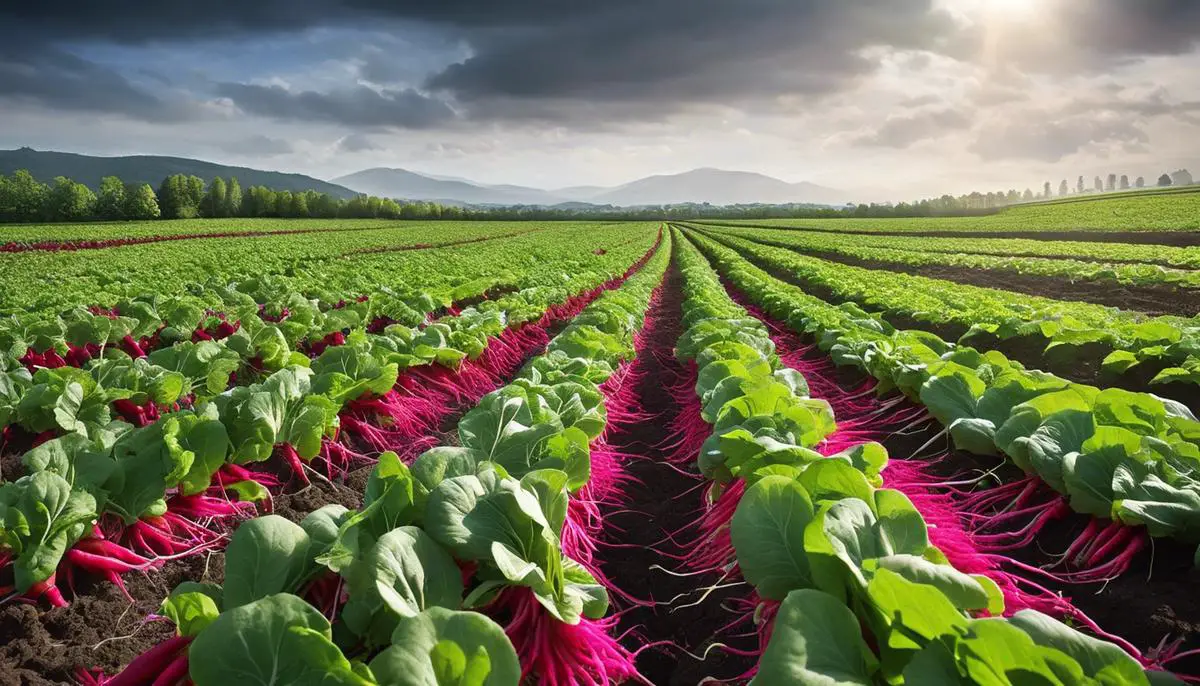
Monitoring and Diagnostic Techniques
Radish (Raphanus sativus)
, a widely cultivated root crop, often encounters significant hurdles due to pests and diseases. To attain successful management and sustainable production practices, advanced monitoring and diagnostic techniques remain crucial. These methodologies enable the early detection of biotic stress factors, contributing to an informed and targeted intervention approach that preserves the integrity of both the crop and the environment. The ensuing discussion delineates advanced techniques pivotal for identifying and managing radish pests and diseases not previously mentioned.Leveraging Remote Sensing and Precision Agriculture:
Remote sensing technology, including the use of unmanned aerial vehicles (drones) equipped with multispectral cameras, provides a non-invasive avenue to scout for pest and disease outbreaks. Image analysis can reveal stress signatures before they become visible to the naked eye, facilitating prompt management actions.Molecular Diagnostic Tools:
Polymerase chain reaction (PCR) and its variants, such as quantitative PCR (qPCR) and loop-mediated isothermal amplification (LAMP), present precise methods for the detection of pathogens at the genetic level. These molecular techniques can identify even low levels of pathogens, such as the spores of Albugo candida or the DNA of Meloidogyne species in the soil, outperforming traditional culturing methods in both speed and sensitivity.Serological assays, employing ELISA (Enzyme-Linked Immunosorbent Assay), enable rapid in-field testing for many pathogens. These assays can detect proteins and other antigens specific to pathogens like Rhizoctonia solani and are useful for routine screening.
Soil Health Analysis:
A comprehensive soil health analysis, including bioassays, can determine the presence and virulence of soil-borne pathogens and pests. Understanding the soil microbiome composition through metagenomics can shed light on potential biological control agents and help craft disease-suppressive soil management practices.Electron Microscopy:
Scanning electron microscopy (SEM) and transmission electron microscopy (TEM) provide high-resolution imagery of pest and pathogen morphology. This contributes to a granular understanding of infection mechanisms and aids in the differentiation of closely related pest and pathogen species.Disease Forecasting Models:
By integrating environmental data with biological understanding, predictive models can forecast disease incidents. These models can anticipate outbreaks of powdery mildew or clubroot, enabling preemptive action based on environmental triggers such as humidity or soil temperature.Integration of Digital Data Management:
Advances in informatics permit the collection and analysis of large datasets (big data) from various monitoring techniques. Decision support systems, powered by artificial intelligence (AI) and machine learning algorithms, can assimilate this data to provide real-time advice for pest and disease management.In summary, the perspective advanced herein underscores the imperative of advanced monitoring and diagnostic techniques—non-destructive remote sensing, precision molecular diagnostics, comprehensive soil health assessments, refined electron microscopy, predictive modeling, and sophisticated data management. The fusion of these methods with traditional IPM strategies fortifies radish crop defense measures, steering towards a future of resilient and sustainable radiculture. Transcending conventional approaches and embracing innovation, these technological advancements epitomize the epitome of scientific endeavor in plant pathology and entomology, striving to safeguard and enhance global food security.
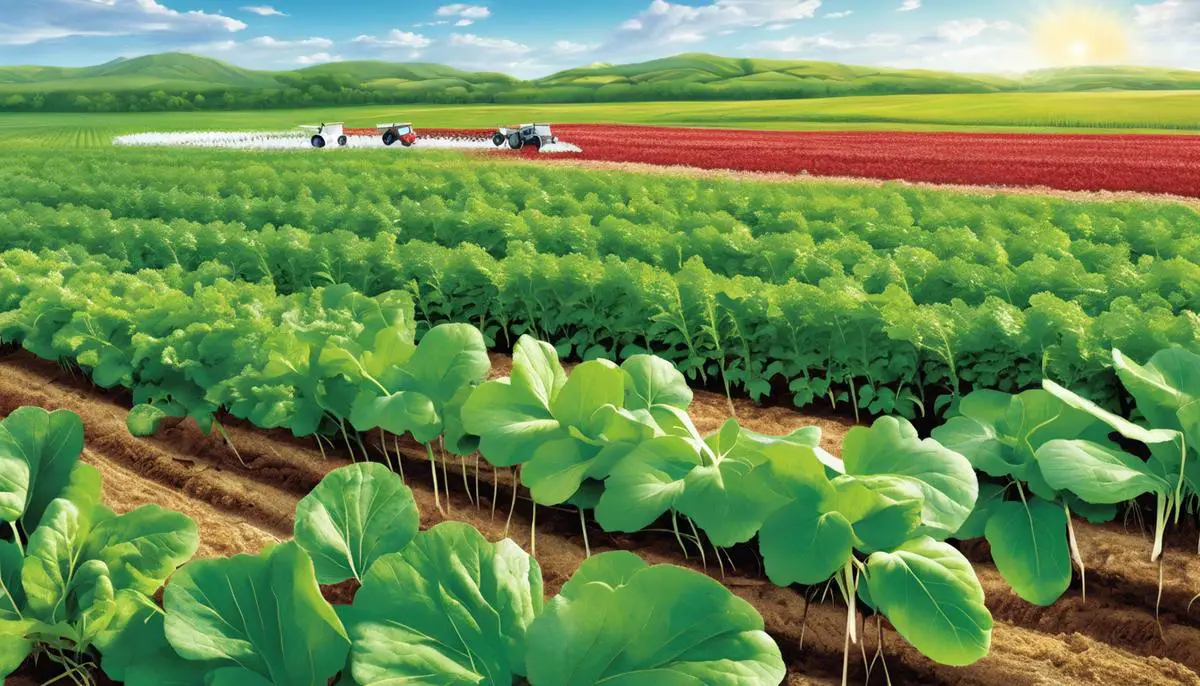
The tapestry of information woven throughout this discussion highlights the multifaceted approach required to preserve radish crops in the face of biological threats. Our exploration across the spectrum from pest identification to pathogenic battles, and from integrated management to advanced diagnostic techniques, underscores the necessity of a harmonious fusion of science, diligence, and innovation in agriculture. As we continue to seek balance with nature, it is this blend of knowledge and application that will ensure not only the survival but the thriving of radishes in gardens and farms worldwide. Ultimately, the lessons learned from studying radishes extend far beyond their beds, informing broader agricultural practices and contributing to a more sustainable, resilient food future for all.

